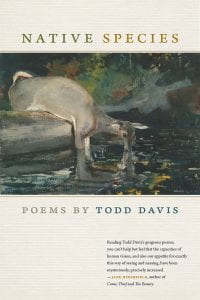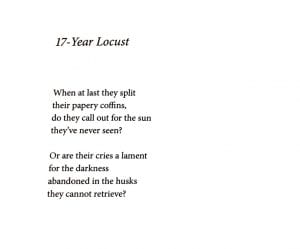by Omou Barry ~
On November 14, Penn State-Altoona professor Todd Davis visited the University Park campus to give a poetry reading as part of the Mary E. Rolling Reading Series. To prepare for his visit, as well as to prepare for selecting poems for their own literary magazine, the students in the Klio class (ENGL 209) read and discussed Davis’ most recent and sixth collection of poetry, Native Species (Michigan State University Press, 2019).
In this review, student Omou Barry shares her impressions of and reactions to her favorite poems in the collection.
 The poems in Todd Davis’ Native Species take readers on different journeys through nature, leading us to specific moments and encounters with the natural world. They are poems that help us see life (and death) in new ways. Davis’ way with words is especially noteworthy in this, his sixth book, where he both laments and marvels at nature, personifies Mother Nature, and reveals the reactions of those within her presence.
The poems in Todd Davis’ Native Species take readers on different journeys through nature, leading us to specific moments and encounters with the natural world. They are poems that help us see life (and death) in new ways. Davis’ way with words is especially noteworthy in this, his sixth book, where he both laments and marvels at nature, personifies Mother Nature, and reveals the reactions of those within her presence.
Although it’s hard to compare Davis’ unique voice to many writers, his poetry reminds me of the potent words that have come from Robert Frost, Henry David Thoreau and Emily Dickinson, who used Mother Nature to draw content from. One notable thing I liked about his writing was that he drew from his personal life and wove in nature to reflect his on life. He’s very open with his life experiences within the book, giving us more of an insight to who he is as a person with every poem.
Three of my favorite poems in the collection are: “17-Year Locust,” “And If There Is a Day of Resurrection” and “Hexagonal.”
In “17-Year Locust,” a brief poem written as two direct questions, Davis ponders the existence of a locust who lies underneath the ground until birth. His startling imagery personifies the locust, an insect often given negative connotations, and suggests the victory of a locust’s life by giving it a religious context with the number 17. The poem specifically touches on the birth of the insects–how they are put in the ground to be born and dig their way out to this new existence beneath the sun. Seventeen is a number in the Bible that reflects victory, the victorious nature of birth. One can easily relate this to birth in general, how all beings come from darkness and enter this earth, learning to live and survive one step at a time.
Another poem, “And If There Is a Day of Resurrection” (originally published in the environmental Orion Magazine), offers several images of death in the natural world, like “coffin flies, the air bluing as the sun’s light dries insect wings,” “coyote’s hinged jaw still clutched around the rabbit’s femur,” and “the bear skull on the ridge.” These images convey a tone that is ominous like the title. As you continue reading, the poem shifts its tone from ominous to one of admiration, as shown in the last few lines: “may all the bones of the living and dead rise/with skeletal praise, this ancient world being remade/in their image.” An important theme raised in the poem is life and death, and in showing that cycle, he touches on the prey versus predator of nature with his example of the coyote and the rabbit, which reflects on the lack of control we have when it comes time to be resurrected.
In his poem “Hexagonal,” one thing you notice from the start is the striking shape of the poem, that reflects the sides of a hexagon. And it further makes sense when you begin reading the poem, as it talks about bees. He describes the honeybee comb as: “Chambers laid out in wax/Like the exposed architecture/of heaven, and like heaven the sun/shines eternally….”
His tone here is reverent; he finds such beauty in the form of honeybee combs. The poem is a beautiful ode to the power of bees within our ecosystem, the way they spread beauty with the spread of pollen, which creates a field of flowers, such as clover, goldenrod, and purple aster. And it also alludes to the destructive hand of humankind (“entire colonies destroyed by carelessness”) as we prematurely send bees heavenward.
Native Species is a cumulation of what nature is to mankind, the way it is an ever–present feature in our lives that has layers to it, many of those layers unseen or unnoticed by the human eye. In Native Species, Davis’s writing is beautiful, powerful, and vivid. He creates a serene, yet ominous atmosphere with his work that is both inviting and challenging to readers. It’s a great read for anyone who loves poetry and nature, and I would highly recommend it.
Related content:
Read an interview with Todd Davis, published earlier this fall on Klio, written by student Brendan Sutcliffe.
Listen to Todd Davis reading his poem “Jacklighting,” a 2011 Pennsylvania Center for the Book Public Poetry Project selection:

